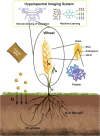Applications of a Hyperspectral Imaging System Used to Estimate Wheat Grain Protein: A Review
- PMID: 35463397
- PMCID: PMC9024351
- DOI: 10.3389/fpls.2022.837200
Applications of a Hyperspectral Imaging System Used to Estimate Wheat Grain Protein: A Review
Abstract
Recent research advances in wheat have focused not only on increasing grain yields, but also on establishing higher grain quality. Wheat quality is primarily determined by the grain protein content (GPC) and composition, and both of these are affected by nitrogen (N) levels in the plant as it develops during the growing season. Hyperspectral remote sensing is gradually becoming recognized as an economical alternative to traditional destructive field sampling methods and laboratory testing as a means of determining the N status within wheat. Currently, hyperspectral vegetation indices (VIs) and linear nonparametric regression are the primary tools for monitoring the N status of wheat. Machine learning algorithms have been increasingly applied to model the nonlinear relationship between spectral data and wheat N status. This study is a comprehensive review of available N-related hyperspectral VIs and aims to inform the selection of VIs under field conditions. The combination of feature mining and machine learning algorithms is discussed as an application of hyperspectral imaging systems. We discuss the major challenges and future directions for evaluating and assessing wheat N status. Finally, we suggest that the underlying mechanism of protein formation in wheat grains as determined by using hyperspectral imaging systems needs to be further investigated. This overview provides theoretical and technical support to promote applications of hyperspectral imaging systems in wheat N status assessments; in addition, it can be applied to help monitor and evaluate food and nutrition security.
Keywords: grain protein; hyperspectral imaging; machine learning; vegetation index; wheat.
Copyright © 2022 Ma, Zheng and He.
Conflict of interest statement
The authors declare that the research was conducted in the absence of any commercial or financial relationships that could be construed as a potential conflict of interest.
Figures

Similar articles
-
Research on the Method of Imperfect Wheat Grain Recognition Utilizing Hyperspectral Imaging Technology.Sensors (Basel). 2024 Oct 8;24(19):6474. doi: 10.3390/s24196474. Sensors (Basel). 2024. PMID: 39409514 Free PMC article.
-
Multi-Temporal and Spectral Analysis of High-Resolution Hyperspectral Airborne Imagery for Precision Agriculture: Assessment of Wheat Grain Yield and Grain Protein Content.Remote Sens (Basel). 2018;10(6):930. doi: 10.3390/rs10060930. Epub 2018 Jun 12. Remote Sens (Basel). 2018. PMID: 32704487 Free PMC article.
-
Reviving grain quality in wheat through non-destructive phenotyping techniques like hyperspectral imaging.Food Energy Secur. 2023 Sep 3;12(5):e498. doi: 10.1002/fes3.498. eCollection 2023 Sep. Food Energy Secur. 2023. PMID: 38440412 Free PMC article. Review.
-
Crop nitrogen monitoring: Recent progress and principal developments in the context of imaging spectroscopy missions.Remote Sens Environ. 2020 Jun;242:111758. doi: 10.1016/j.rse.2020.111758. Remote Sens Environ. 2020. PMID: 36082364 Free PMC article.
-
Hyperspectral remote sensing for tobacco quality estimation, yield prediction, and stress detection: A review of applications and methods.Front Plant Sci. 2023 Mar 8;14:1073346. doi: 10.3389/fpls.2023.1073346. eCollection 2023. Front Plant Sci. 2023. PMID: 36968402 Free PMC article. Review.
Cited by
-
A model for inversion of hyperspectral characteristics of phosphate content in mural plaster based on fractional-order differential algorithm.Sci Rep. 2024 Aug 2;14(1):17898. doi: 10.1038/s41598-024-68594-2. Sci Rep. 2024. PMID: 39095559 Free PMC article.
-
Micronutrient Biofortification in Wheat: QTLs, Candidate Genes and Molecular Mechanism.Int J Mol Sci. 2025 Feb 28;26(5):2178. doi: 10.3390/ijms26052178. Int J Mol Sci. 2025. PMID: 40076800 Free PMC article. Review.
-
Challenges facing sustainable protein production: Opportunities for cereals.Plant Commun. 2023 Nov 13;4(6):100716. doi: 10.1016/j.xplc.2023.100716. Epub 2023 Sep 14. Plant Commun. 2023. PMID: 37710958 Free PMC article. Review.
-
Ensuring Explainability and Dimensionality Reduction in a Multidimensional HSI World for Early XAI-Diagnostics of Plant Stress.Entropy (Basel). 2023 May 15;25(5):801. doi: 10.3390/e25050801. Entropy (Basel). 2023. PMID: 37238556 Free PMC article.
-
Dynamic monitoring of maize grain quality based on remote sensing data.Front Plant Sci. 2023 Jun 22;14:1177477. doi: 10.3389/fpls.2023.1177477. eCollection 2023. Front Plant Sci. 2023. PMID: 37426960 Free PMC article.
References
-
- Asseng S., Milroy S. P. (2006). Simulation of environmental and genetic effects on grain protein concentration in wheat. Eur. J. Agron. 25 119–128. 10.1016/j.eja.2006.04.005 - DOI
-
- Barnes E., Clarke T. R., Richards S. E., Colaizzi P., Haberland J., Kostrzewski M., et al. (2000). “Coincident detection of crop water stress, nitrogen status and canopy density using ground-based multispectral data,” in Proceedings of the 2000 5th International Conference on Precision Agriculture, Bloomington, MN, 1–15. 10.1094/cm-2009-1211-01-rs - DOI
Publication types
LinkOut - more resources
Full Text Sources

